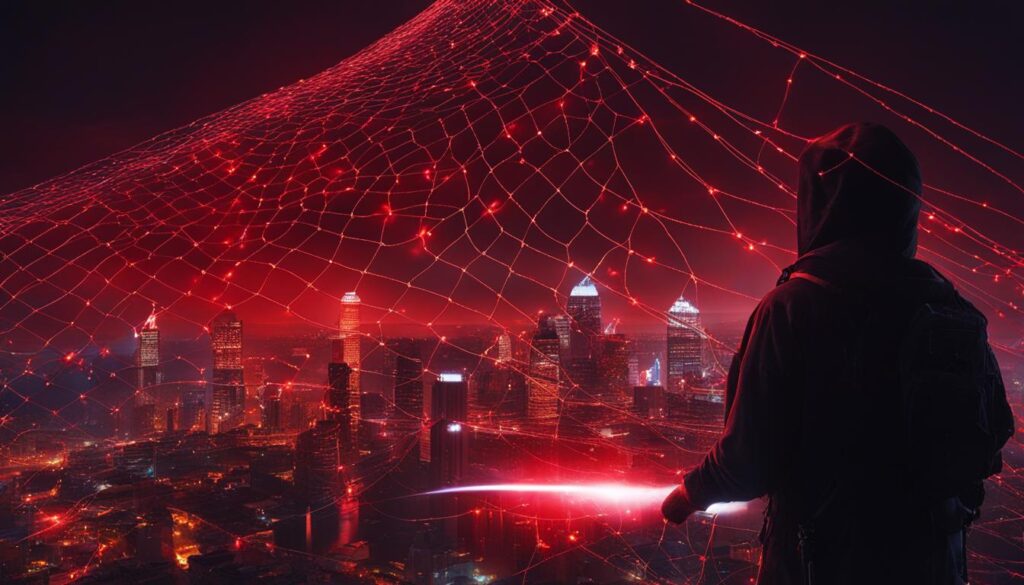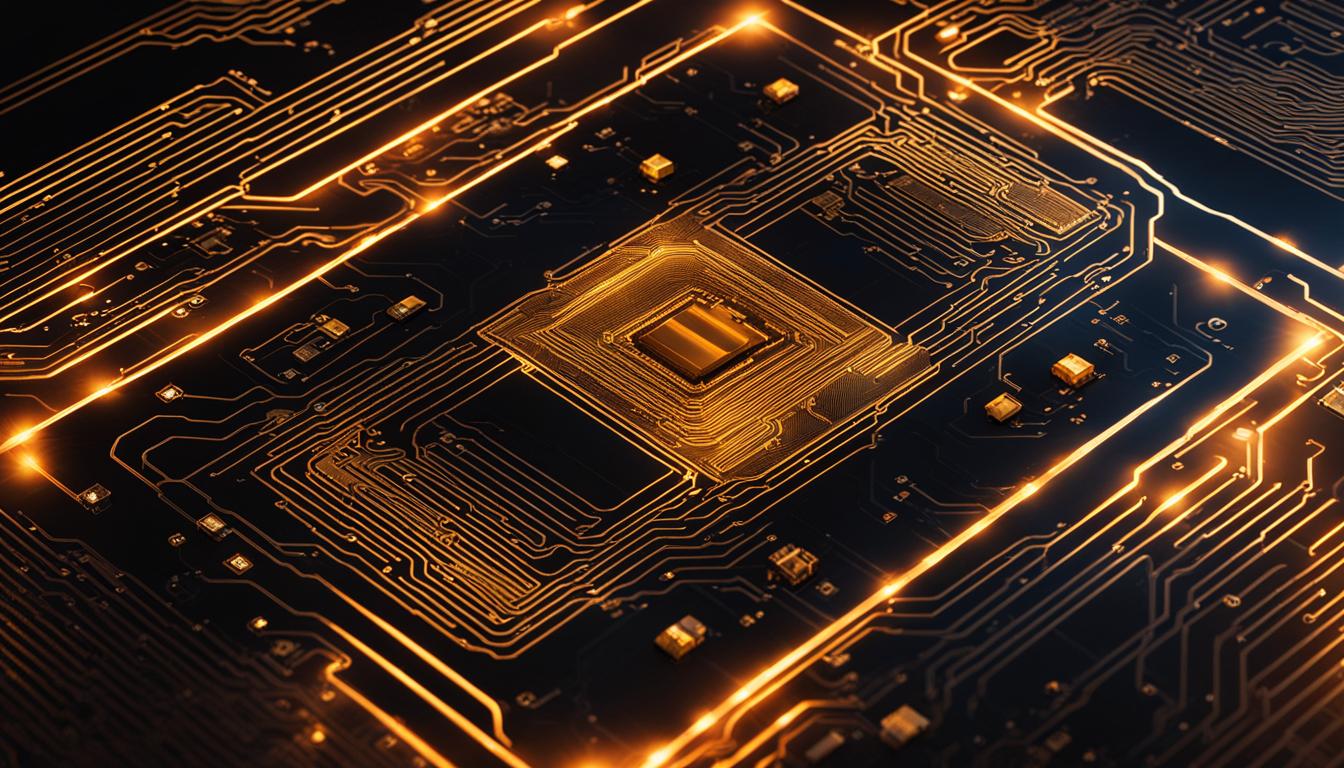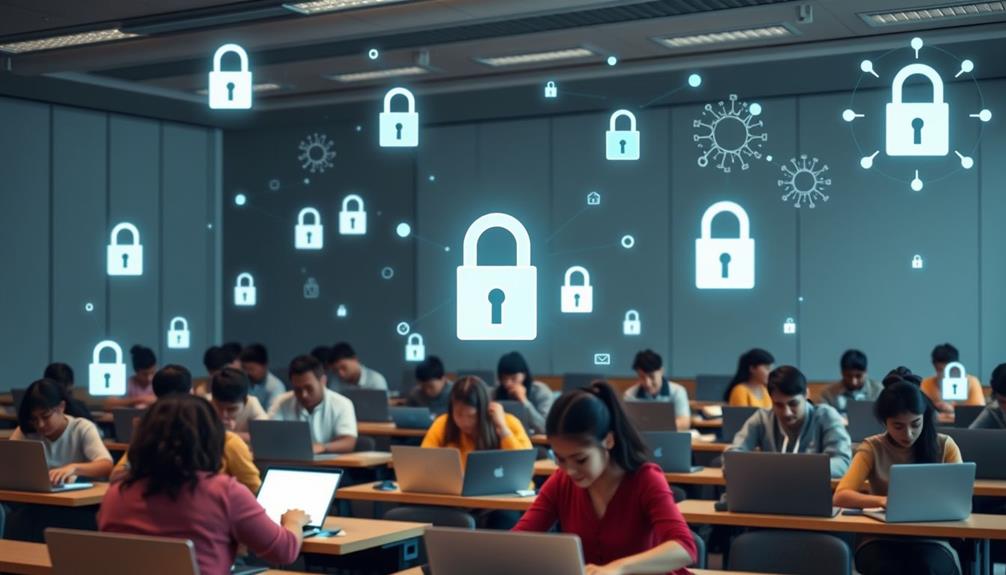Welcome to our latest article where we explore the exciting intersection of artificial intelligence (AI) and cybersecurity. As organizations increasingly adopt AI technology, we are witnessing a revolution in the field of cybersecurity. AI has the potential to replicate human decision-making and problem-solving processes, harnessing its powerful algorithms and computational capabilities. In this article, we will delve into the impact of AI on cybersecurity and explore the future of this dynamic field.
AI brings a multitude of benefits to cybersecurity, including automation, predictive analysis, real-time threat detection, vulnerability management, and improved network security. These advancements can enhance our defenses against cyber threats and provide proactive solutions. However, as with any innovation, there are also challenges and risks to consider, such as investment costs and the need for skilled professionals.
Key Takeaways:
- AI is revolutionizing the field of cybersecurity with its ability to replicate human decision-making and problem-solving processes.
- Benefits of AI in cybersecurity include automation, predictive analysis, real-time threat detection, vulnerability management, and improved network security.
- Challenges and risks, such as investment costs and the need for skilled professionals, must also be considered.
- The future of cybersecurity with AI holds great promise, but organizations must navigate these challenges to fully harness its potential.
- By leveraging AI advancements, we can enhance our defenses and stay one step ahead of cyber threats.
What is AI?
Artificial Intelligence (AI) is a revolutionary technology that replicates human intelligence by utilizing complex algorithms, statistical models, and computational power. It enables machines to acquire knowledge, make decisions, and solve problems in a manner similar to humans. Through machine learning, AI systems can adapt and improve their performance over time, making them capable of handling complex tasks that surpass human capabilities.
AI technology works by processing vast amounts of data, evaluating patterns, and using this information to make predictions or decisions. It can perform tasks at a higher level and faster rate than humans, making it invaluable in many industries, including cybersecurity.
AI has various applications across different domains, such as natural language processing, computer vision, and robotics. In cybersecurity, AI plays a crucial role in automating processes, enhancing threat detection, and improving network security. By leveraging AI-powered solutions, organizations can benefit from automation, predictive analysis, real-time threat detection, vulnerability management, and improved overall cybersecurity.

AI Applications
AI finds applications in various areas, including:
- Automated Threat Detection: AI algorithms can analyze network traffic, identify patterns, and detect anomalies in real time, enabling organizations to respond quickly to potential threats.
- Vulnerability Management: AI-powered systems can automate the detection, identification, and remediation of known vulnerabilities, strengthening an organization’s security posture.
- Predictive Analysis: By analyzing historical and present data, AI can identify potential vulnerabilities and risks before they occur, allowing proactive measures to be taken to mitigate the impact.
- Enhanced Network Security: AI can monitor and track network traffic, detect anomalies, and manage endpoint lifecycle, providing a robust defense against cyber threats.
“AI technology is revolutionizing the field of cybersecurity, empowering organizations to automate processes, improve threat detection, and enhance overall network security.”
AI Benefits for Cybersecurity
Artificial Intelligence (AI) integrated with machine learning algorithms offers significant advantages for cybersecurity. By leveraging AI technology, organizations can enhance their defense mechanisms and strengthen their overall security posture. Let’s take a closer look at some key benefits of using AI in cybersecurity:
Automation in Cybersecurity
AI-powered automation simplifies and accelerates various cybersecurity processes. It eliminates manual tasks, such as data analysis, threat hunting, and incident response, allowing security professionals to focus their efforts on more strategic initiatives. With AI automation, organizations can detect and respond to threats in real-time, minimizing the impact of potential cyber attacks.
Predictive Analysis in Cybersecurity
AI’s predictive analysis capabilities enable organizations to proactively identify vulnerabilities and predict potential cyber threats. By analyzing historical and real-time data, AI algorithms can identify patterns and anomalies, providing early warnings of potential security breaches. This empowers cybersecurity teams to take preventive actions and implement timely security measures to mitigate risks.
Real-Time Threat Detection in Cybersecurity
AI-powered cybersecurity solutions excel at real-time threat detection. By continuously monitoring and analyzing network traffic, AI algorithms can identify and respond to suspicious activities in milliseconds. This enables organizations to detect and mitigate emerging threats promptly, reducing the vulnerability window and preventing potentially devastating cyber attacks.
Vulnerability Management in Cybersecurity
AI plays a critical role in vulnerability management by automating the detection, identification, and remediation of known vulnerabilities. Through continuous scanning and analysis, AI-powered systems can identify and prioritize vulnerabilities based on their potential impact and exploitability. This helps organizations efficiently allocate resources and address vulnerabilities before they can be exploited by threat actors.
Network Security with AI
AI enhances network security by monitoring and tracking network traffic in real-time. It can detect anomalies and suspicious activities that may indicate unauthorized access or potential security breaches. AI-powered network security solutions provide organizations with comprehensive visibility into their network infrastructure, enabling proactive defense measures and effective response to emerging threats.
Overall, AI brings numerous benefits to cybersecurity, from automation and predictive analysis to real-time threat detection and vulnerability management. By harnessing the power of AI, organizations can stay one step ahead of cyber threats and safeguard their critical assets.
| Benefits | Description |
|---|---|
| Automation | AI streamlines cybersecurity processes and eliminates manual tasks. |
| Predictive Analysis | AI enables proactive identification of vulnerabilities and prediction of threats. |
| Real-Time Threat Detection | AI detects and responds to threats in real-time, minimizing the impact of cyber attacks. |
| Vulnerability Management | AI automates the detection, identification, and remediation of known vulnerabilities. |
| Network Security | AI enhances network security by monitoring and tracking network traffic. |
“AI brings numerous benefits to cybersecurity, from automation and predictive analysis to real-time threat detection and vulnerability management.”
AI Challenges and Risks in Cybersecurity
As AI technology continues to advance and be integrated into cybersecurity systems, it brings with it a set of challenges and risks that organizations must navigate. While the benefits of AI in cybersecurity are significant, it is important to be aware of the potential drawbacks and take proactive measures to address them.
One of the main challenges is the high investment costs associated with implementing AI cybersecurity solutions. The design and maintenance of AI systems require resources and expertise, which can be a barrier for smaller organizations with limited budgets. Additionally, training AI models with accurate and reliable data sets can be time-consuming and complex.
Another significant risk is the emergence of AI-powered attacks. Deepfake social engineering and automated malware are examples of how adversaries can leverage AI technology to create sophisticated and targeted cyber attacks. These attacks pose new and evolving risks that organizations need to be prepared to defend against.
Key Challenges and Risks in AI Cybersecurity
To summarize, the challenges and risks of using AI in cybersecurity are:
- High investment costs
- Complexity in designing and maintaining AI systems
- Time-consuming data training process
- Emergence of AI-powered attacks
It is crucial for organizations to ensure the ethical and responsible use of AI in cybersecurity. This involves implementing strong governance frameworks, adhering to established ethical guidelines, and continuously monitoring and updating AI systems to mitigate any potential risks. Furthermore, addressing the skills shortage in the cybersecurity industry and investing in training and education programs can help bridge the gap and ensure that organizations have the necessary expertise to leverage AI effectively and securely.
AI in cybersecurity offers numerous benefits, but organizations must be vigilant in understanding and mitigating the challenges and risks. It is only through a comprehensive approach that combines cutting-edge AI technology, skilled professionals, and robust governance that we can harness the power of AI to protect against evolving cyber threats.
Generative AI and AI-Powered Attacks
As we look into the future of cybersecurity, one area that stands out is the rise of generative AI and its impact on AI-powered attacks. Generative AI tools have the ability to accelerate the adoption of AI in cybersecurity, shaping the way attackers carry out their malicious activities. One notable example is the use of deepfake attacks, where AI technology is employed to create highly convincing and realistic fake content, such as videos or audio recordings.

Deepfake attacks pose a significant threat as they can be used for various malicious purposes, including social engineering, disinformation campaigns, and fraud. With the advancements in AI, attackers can now create more sophisticated and personalized attacks that are difficult to detect and defend against. These attacks not only exploit the vulnerabilities of individuals and organizations but also undermine trust and credibility in the digital realm.
To combat the growing threat of AI-powered attacks, organizations need to prioritize awareness, education, and the implementation of AI-based defense mechanisms. AI systems can help in identifying and mitigating deepfake attacks by analyzing patterns and inconsistencies in the content. Additionally, adopting a zero trust approach that continuously monitors and verifies the identity and behavior of users and devices can add an extra layer of protection against AI-powered attacks.
Challenges in Detecting Deepfake Attacks
Detecting deepfake attacks is a challenging task due to the sophistication of the technology involved. Traditional methods of authentication and verification may be insufficient in identifying manipulated content. As deepfake technology becomes more advanced, it is crucial for cybersecurity professionals to stay updated with the latest techniques and tools for detecting and preventing these attacks.
Table:
| Challenges | Solutions |
|---|---|
| Lack of training data | Building large and diverse datasets for training AI models to detect deepfake content |
| Evolution of deepfake technology | Continuous research and development of AI-based algorithms to counter emerging deepfake techniques |
| Human judgment and visual inspection | Combining AI algorithms with human expertise to verify the authenticity of content |
By understanding the challenges and implementing effective solutions, we can better equip ourselves against the rising tide of generative AI and AI-powered attacks. It is crucial to foster collaboration between cybersecurity professionals, researchers, and policymakers to develop robust defense strategies and create a safer digital environment.
Next-Level Phishing Attacks
In today’s digital landscape, phishing attacks have become increasingly sophisticated, and the use of generative AI tools is poised to take these attacks to the next level. Attackers are now able to create smarter and more personalized approaches, including the use of deepfake technology. With generative AI, attackers can create convincing fake emails and messages that are tailored to deceive specific individuals or organizations.

Imagine receiving an email that appears to be from your CEO or a familiar colleague, but it’s actually an AI-generated message designed to trick you into revealing sensitive information or performing fraudulent actions. These deepfake phishing attacks can be difficult to detect and can have devastating consequences for individuals and organizations.
To mitigate the risk of next-level phishing attacks, organizations need to prioritize awareness and education. Employees should be trained to recognize the signs of phishing attempts and to verify the authenticity of emails and messages before taking any action. Implementing multi-factor authentication and encryption can also provide an added layer of security.
Example of a Phishing Attack email:
“Hello [Recipient’s Name],
I hope this email finds you well. I urgently need your assistance regarding a confidential matter. Please review the attached document and provide your feedback as soon as possible. Your prompt attention to this request is greatly appreciated.
Sincerely,
[Sender’s Name] CEO, XYZ Corporation”
Furthermore, organizations can leverage AI systems to detect and respond to phishing attacks in real-time. AI-powered algorithms can analyze incoming emails and identify suspicious patterns or characteristics that indicate a potential phishing attempt. By combining AI technology with regular security updates and employee training, organizations can strengthen their defense against next-level phishing attacks.
Cybersecurity in the Board Room
In today’s digital landscape, cybersecurity is no longer just a technical concern. It has become a strategic priority that demands the attention and involvement of board directors. As organizations face increasingly sophisticated cyber threats, board members are recognizing the need to possess cybersecurity expertise and knowledge. The board room is now a critical space for discussions on cybersecurity governance and the responsibilities of board directors in ensuring the security and resilience of the organization’s digital assets.
Cybersecurity governance involves establishing policies, procedures, and frameworks to guide the organization’s approach to cybersecurity. Board directors play a crucial role in setting the strategic direction, overseeing risk management, and ensuring compliance with relevant regulations and industry standards. They are responsible for taking a proactive approach to cybersecurity, staying informed about the latest threats and trends, and making informed decisions to protect the organization against potential cybersecurity risks.
In recent years, boards have been devoting more time and resources to cybersecurity. They are seeking to broaden their knowledge and skills through specialized training programs and are increasingly collaborating with cybersecurity leaders and experts to enhance their understanding of the evolving threat landscape. However, there are areas where improvements can be made.
Cybersecurity Responsibilities of Board Directors
- Establishing a cybersecurity culture: Board directors should foster a cybersecurity-conscious culture within the organization, promoting a shared responsibility for cybersecurity among all employees.
- Third-party cybersecurity risk considerations: Boards need to ensure that third-party vendors and partners adhere to robust cybersecurity practices to minimize the risk of breaches through external connections.
- Cyber program maturity assessments: Regular assessments of the organization’s cybersecurity program are essential to identify areas for improvement and ensure the effectiveness of security measures.
In conclusion, the board room plays a critical role in shaping an organization’s cybersecurity strategy. Board directors need to develop a deep understanding of cybersecurity governance, take an active role in overseeing cybersecurity measures, and collaborate with cybersecurity leaders to effectively protect the organization against cyber threats.

| Responsibilities of Board Directors | Actions |
|---|---|
| Establishing a cybersecurity culture | Foster a cybersecurity-conscious culture within the organization and promote a shared responsibility for cybersecurity among all employees. |
| Third-party cybersecurity risk considerations | Ensure that third-party vendors and partners adhere to robust cybersecurity practices to minimize the risk of breaches through external connections. |
| Cyber program maturity assessments | Conduct regular assessments of the organization’s cybersecurity program to identify areas for improvement and ensure the effectiveness of security measures. |
IoT Cyber Attacks
The increasing number of connected devices, including those used for remote work, poses significant cybersecurity risks. Internet of Things (IoT) devices often lack proper security protocols and can be vulnerable to attacks. Weak passwords and insecure operations make home consumer IoT devices especially at risk. It is crucial for organizations and individuals to prioritize the security of IoT devices and networks to mitigate these risks and protect sensitive data.
IoT cyber attacks can have severe consequences, including unauthorized access to personal information, disruption of critical infrastructure, and even physical harm. Attackers can exploit vulnerabilities in IoT devices to gain control over them, enabling them to launch distributed denial-of-service (DDoS) attacks, infiltrate networks, and gather sensitive data. Furthermore, compromised IoT devices can be used as entry points to launch attacks on other connected devices and systems.
To address these challenges, organizations and individuals should adopt best practices for securing IoT devices. This includes regularly updating firmware and software, using strong and unique passwords, disabling unnecessary features, and implementing network segmentation to isolate IoT devices from critical systems. It is also essential to stay informed about the latest security threats and vulnerabilities in IoT devices and implement appropriate security measures.
Key considerations for securing IoT devices:
- Implement strong authentication mechanisms, such as two-factor authentication, to prevent unauthorized access to IoT devices.
- Regularly update firmware and software to ensure devices are protected against known vulnerabilities.
- Disable unnecessary features and services that may introduce additional security risks.
- Segment IoT devices from critical systems to minimize the potential impact of a compromised device.
- Monitor network traffic and behavior of IoT devices for any signs of suspicious activity.
By taking proactive steps to secure IoT devices, organizations and individuals can mitigate the cybersecurity risks associated with the increasing number of connected devices and safeguard their data and privacy.

Cyber Resilience – Beyond Cyber Security
In the ever-evolving landscape of cybersecurity, it’s crucial to go beyond traditional security measures and embrace cyber resilience. While cybersecurity focuses on preventing attacks, cyber resilience ensures the continuity of operations even after a breach. It’s about being prepared for the inevitable, adapting to emerging threats, and quickly recovering from disruptions.
At its core, cyber resilience means understanding that breaches will happen and focusing on minimizing the impact. It involves building robust systems that can withstand attacks, detecting and responding to incidents promptly, and recovering operations swiftly. Cyber resilience goes beyond technical solutions; it encompasses organizational culture, processes, and a proactive mindset.
In today’s digital world, businesses must prioritize cyber resilience to safeguard their operations and protect sensitive data. By investing in technologies, such as AI-powered threat intelligence and real-time monitoring, organizations can detect and respond to threats more effectively. Additionally, implementing backup and recovery mechanisms ensures the continuity of critical operations, minimizing downtime and data loss in the event of an incident.
Resilience in Cybersecurity
Resilience in cybersecurity means being able to adapt and respond to ever-changing threats, evolving technologies, and emerging attack vectors. It involves proactive planning, regular assessments, and continuous improvement to strengthen security postures. Cyber resilience also entails fostering a culture of cybersecurity awareness and empowering employees to respond effectively to potential incidents.
Ensuring cyber resilience requires collaboration across departments and stakeholders, as well as ongoing evaluation and adaptation of security measures. By embracing cyber resilience, organizations can better navigate the complex and evolving cybersecurity landscape, ensuring the continuity of operations and minimizing the impact of breaches.
Continuity of Operations
The continuity of operations is a critical aspect of cyber resilience. It encompasses the ability to maintain essential business functions and services during and after a cyber incident. Organizations must have robust plans in place to ensure that operations can continue, even if systems are compromised or disrupted.
This includes having backup systems, data recovery processes, and clear communication channels to keep stakeholders informed. Regular testing and simulation exercises help identify gaps and weaknesses in continuity plans, allowing for timely improvements. By prioritizing continuity of operations, organizations can minimize the financial, reputational, and operational impacts of cyber incidents.
Less Than Zero Trust
In the ever-evolving landscape of cybersecurity, the concept of zero trust has gained momentum as organizations seek to strengthen their defenses against sophisticated cyber threats. Zero trust challenges the traditional notion of a secure perimeter and recognizes that not all users or devices within a network can be trusted. As we look ahead to 2024, zero trust is set to take on a new dimension, becoming more adaptive and holistic, enabled by continuous AI-powered real-time authentication and activity monitoring.
Continuous authentication is a key component of the less than zero trust model. Rather than relying solely on a one-time authentication process, continuous authentication ensures that users are continuously and dynamically authenticated throughout their session. This helps to prevent unauthorized access and identify any suspicious activities in real time. By continuously monitoring user behavior, such as keystrokes, mouse movements, and device interactions, organizations can detect anomalies and respond promptly to potential threats.
Activity monitoring is another important aspect of the less than zero trust model. It involves the constant monitoring and analysis of user activities and network traffic. By analyzing activity logs and network data, organizations can identify patterns, detect unusual behaviors, and respond to potential security incidents in a timely manner. Activity monitoring also provides valuable insights into user behavior, which can be used to enhance security policies and training programs.
Implementing the less than zero trust model requires a shift in mindset and a comprehensive approach to cybersecurity. It involves a combination of technology, processes, and people. Organizations need to invest in advanced AI-powered authentication solutions and deploy robust monitoring and analysis tools. They also need to implement strong access controls, enforce the principle of least privilege, and provide ongoing cybersecurity training to employees. By adopting the less than zero trust model, organizations can enhance their overall network security and better protect their critical assets.
As cyber threats continue to evolve and become more sophisticated, the less than zero trust approach provides a proactive and adaptive defense strategy. By continuously authenticating users and monitoring activities, organizations can significantly reduce the risk of unauthorized access and potential security breaches. As we move into 2024, adopting the less than zero trust model will be crucial in ensuring the security and resilience of organizations’ digital infrastructure.
Cyber Warfare and State-Sponsored Attacks
In today’s interconnected world, cyber warfare has become a prominent tool for states in both military operations and political influence. State-sponsored cyber attacks can range from disruptive tactics to undermine infrastructure to targeted attacks aimed at compromising sensitive information. These attacks often involve sophisticated techniques that exploit vulnerabilities in network systems and employ advanced malware.
One significant area where cyber attacks have been prevalent is in military operations. Cyber warfare has become an integral part of modern warfare, with states employing cyber attacks to disrupt enemy communications, compromise critical infrastructure, and gain strategic advantages. These attacks can have severe consequences, impacting military capabilities and potentially leading to physical destruction.
Another area where state-sponsored cyber attacks have gained attention is in elections. Major elections around the world have been targeted by cyber attackers seeking to manipulate voter sentiment, compromise electoral systems, and undermine the democratic process. These attacks pose a significant threat to the integrity of democratic elections and can have far-reaching implications for national security and international relations.
“Cyber attacks by states have the potential to cause significant damage and disrupt critical systems. It is crucial for governments and organizations to enhance their defenses and response capabilities to mitigate the risks posed by state-sponsored cyber attacks.”
Cyber Attacks in 2024: Trends and Challenges
In the coming years, the frequency and sophistication of state-sponsored cyber attacks are expected to increase. As technology advances and the digital landscape evolves, new vulnerabilities will emerge, creating opportunities for cyber attackers to exploit. It is imperative that governments and organizations remain vigilant and proactive in strengthening their cybersecurity measures to counter these threats.
Furthermore, international cooperation and diplomatic efforts will play a crucial role in combating cyber warfare. Collaborative initiatives will be necessary to establish norms and regulations in cyberspace, promote responsible behavior, and facilitate information sharing between nations. By working together, we can better protect our critical infrastructure, defend against state-sponsored attacks, and safeguard the stability of the digital world.
Conclusion
In reflecting on the cybersecurity landscape in 2024, it is evident that the future of cybersecurity is heavily intertwined with the advancements in AI. The use of AI in cybersecurity will continue to revolutionize the field, offering automation, predictive analysis, real-time threat detection, vulnerability management, and improved network security.
However, while AI brings numerous benefits, it also presents challenges and risks. Organizations must address the skills shortage and invest in cybersecurity professionals with technical and soft skills. Additionally, board directors play a crucial role in cybersecurity governance, and their expertise and involvement are becoming increasingly important.
The rising number of IoT devices and evolving cyber threats call for enhanced security measures. Securing IoT devices and networks should be a priority for organizations to mitigate cybersecurity risks. Furthermore, regulations and compliance will continue to impact cybersecurity practices, requiring organizations to stay up-to-date with the latest standards.
Overall, the future of cybersecurity is a dynamic and ever-evolving landscape. With AI as a transformative force, both defending against attacks and developing more sophisticated attack techniques will be shaped by its advancements. As we move forward, it is crucial that we stay informed, adaptable, and proactive in addressing the emerging cybersecurity trends in 2024 and beyond.
FAQ
What is AI?
AI, or artificial intelligence, refers to technology that simulates human intelligence by replicating decision-making and problem-solving processes. It uses complex algorithms, statistical models, and computational power to acquire and use knowledge and improve performance over time.
What are the benefits of AI for cybersecurity?
AI offers numerous benefits for cybersecurity, including automation of processes, time-saving capabilities, enhanced detection of malware variants, predictive analysis to identify vulnerabilities and risks, real-time threat detection, vulnerability management, and improved network security.
What are the challenges and risks of using AI in cybersecurity?
Some challenges and risks of using AI in cybersecurity include high investment costs, the need for resources and expertise to design and maintain AI systems, time-consuming training of AI models with accurate data sets, and the emergence of AI-powered attacks, such as deepfake social engineering and automated malware.
How can generative AI impact cybersecurity?
Generative AI tools can enable smarter and more personalized cyber attacks, such as deepfake attacks. These AI-powered attacks range from deepfake social engineering to automated malware that adapts to evade detection. Defense against these attacks requires organization-wide awareness, education, and the use of AI and zero trust principles.
What are the risks associated with next-level phishing attacks?
With the use of generative AI tools, phishing attacks can become more sophisticated and personalized, including the use of deepfake techniques. Organizations need to prioritize awareness and education to mitigate the risk of phishing attacks. AI systems and zero trust principles can also play a role in preventing and responding to these attacks.
How can boards contribute to cybersecurity governance?
Boards can contribute to cybersecurity governance by ensuring they have members with cybersecurity expertise, devoting time to cybersecurity discussions, seeking to broaden their knowledge and skills, and increasing collaboration with cybersecurity leaders. They should also consider third-party cybersecurity risk and assess the maturity of their cyber programs.
What are the cybersecurity risks associated with IoT devices?
The increasing number of connected devices, including those used for remote work, poses cybersecurity risks. IoT devices often lack proper security protocols and can be vulnerable to attacks. Weak passwords and insecure operations make home consumer IoT devices especially at risk. Organizations should prioritize securing IoT devices and networks.
What is cyber resilience?
Cyber resilience is an important aspect of cybersecurity that focuses on the ability to recover and continue operations in the event of a breach. While cybersecurity aims to prevent attacks, resilience measures ensure business continuity even after a successful breach. Organizations should prioritize developing the capability to recover quickly, minimize data loss and downtime, and adapt to evolving threats.
What is the concept of zero trust in cybersecurity?
Zero trust challenges the notion of a secure perimeter and extends beyond the corporate network to remote workers, partners, and IoT devices. In 2024, zero trust becomes adaptive and holistic, enabled by continuous AI-powered real-time authentication and activity monitoring. It helps mitigate the risk of insider threats and improve overall network security.
How prevalent are cyber attacks in military and civilian operations?
Cyber warfare is increasingly used by states in military and civilian operations. Common tactics include phishing attacks and distributed denial-of-service attacks. In 2024, cyber attacks are expected to be prevalent in military operations worldwide, and major elections may face increased cyber threats. Governments and organizations need to enhance their defenses and response capabilities against state-sponsored attacks.
What can we expect in the cybersecurity landscape in 2024?
The cybersecurity landscape in 2024 will be shaped by advancements in AI and the increasing importance of cyber resilience. Organizations need to address the skills shortage and invest in cybersecurity professionals with both technical and soft skills. Board directors play a crucial role in cybersecurity governance. The rising number of IoT devices and evolving cyber threats require enhanced security measures. Regulations and compliance will continue to impact cybersecurity practices. Overall, AI will have a transformative impact on cybersecurity, both in defending against attacks and in the development of more sophisticated attack techniques.











